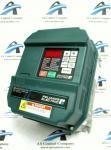About the 1V4122
The 1V4122 is a 1 HP GV3000 3-Phase AC Drive. It was originally created by Reliance Electric and may have also sold under the ABB and Baldor Electric product lines.
The 1V4122 has an input voltage or 380-460 VAC +/-10%. It has a 2.0 KVA and 2.5 maximum input amps. It has a maximum output of 2.1 amps with a power loss wattage of 60. It has a 0.5% speed reference accuracy and a displacement power factor of 0.96. It has a line frequency of 50 Hz or 60 Hz (+/-5Hz). It has a -10 to +10% line voltage variation. The user can use software to select a 2 kHz,4 kHz, or 8 kHz carrier frequency. It has a U.006 to 150% current limit adjustment. It has a 125 kHz maximum pulse tach input frequency. It has a typical 15 Hz speed control response and a 15 V speed feedback. It has a 6 amp AC fuse.
With low-horsepower models such as the Reliance's 1V4122 drive here, it is important to be cognizant of potential faults in drive function. One such fault that disproportionately inconveniences users of this GV3000 series drive is called the earth current failure fault, symbolized by the code EC on this drive's built-in keypad display. This fault may be caused be an unintentional grounding of the output, and to correct this fault, one should check the isolation between the drive's ground and output terminals, replacing defective sensors as deemed necessary. For a more specific breakdown on the EC fault corrective action and causes, please reference Reliance Electric instructional manual D2-3426 & D2-3427.
The 1V4122 is in a NEMA Type-1 rated enclosure. It is 8.75” wide, 11.05” tall, and 7.87” thick. It weighs right around 14 lbs. When mounting the drive, do so vertically making use of the four mounting holes that are on the drive base. It should be mounted in a clean, cool environment. Spacing should be considered and maintained to encourage proper airflow to the drive.
The 1V4122 has a display and keypad on its faceplate. It also has an RS-232 9-pin female port that is attached to the regulator board that can be accessed on the faceplate without needing to remove the enclosure. The regulator board is positioned directly behind the keypad so that its LED display can be seen on the keypad. The regulator board also has a control terminal strip.









